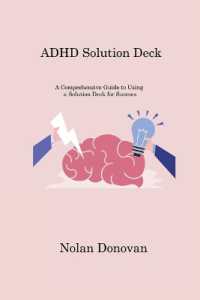- ホーム
- > 洋書
- > 英文書
- > Science / Mathematics
Full Description
NOTE: Before purchasing, check with your instructor to ensure you select the correct ISBN. Several versions of MyLab™ Engineering exist for each title, and registrations are not transferable. To register for and use MyLab Engineering, you may also need a Course ID, which your instructor will provide.
Used books, rentals, and purchases made outside of Pearson
If purchasing or renting from companies other than Pearson, the access codes for MyLab Engineering may not be included, may be incorrect, or may be previously redeemed. Check with the seller before completing your purchase.
For Introduction to engineering courses.
This package includes MyLab Engineering.
Inspire self-guided inquiry with an active learning model
Thinking Like an Engineer: An Active Learning Approach, 4th Edition is designed to facilitate an active learning environment for first year engineering courses. The authors incorporate a model of learning that encourages self-guided inquiry and advances students beyond "plug-and-chug" and memorization of problem-solving methods. Checkpoints throughout each chapter provide worked out problem sets for students to solve using their own logic, before they are ready to tackle more difficult problems. An emphasis on reading and practice before class prepares students for in-class activities that reinforce the chapter's material. Students arrive prepared for class, allowing instructors to spend class time focusing on active learning through collaborative problem-solving, computer-based activities, and hands-on experiments that encourage guided inquiry. The 4th Edition provides new material and revisions based on input from instructors and students, as well as current software releases.
Personalize learning with MyLab Engineering.
MyLab™ Engineering is an online homework, tutorial, and assessment program that truly engages students as it offers customized, self-paced learning with instant feedback. MyLab Engineering gives students unlimited opportunity for practice with feedback and help when they need it most. Students will be prepared ahead of class, allowing you to spend class time focusing on active learning.
0134642252 / 9780134642253 Thinking Like an Engineer: An Active Learning Approach Plus MyLab Enginerring -- Access Card Package
Package consists of:
0134609875 / 9780134609874 MyLab Engineering with Pearson eText -- Access Card -- for Thinking Like an Engineer: An Active Learning Approach
0134639677 / 9780134639673 Thinking Like an Engineer: An Active Learning Approach
Students can use the URL and phone number below to help answer their questions:
http://247pearsoned.custhelp.com/app/home
800-677-6337
Contents
Part 1
Engineering Essentials
Engineering is an . . . Itch!
Chapter 1
Everyday Engineering
1.1 Choosing a Career
1.2 Choosing Engineering as a Career
1.3 NAE Grand Challenges for Engineering
1.4 Choosing a Specific Engineering Field
1.5 Engineering Technology-A Related Field
1.6 Gathering Information
1.7 Pursuing Student Opportunities
Review Questions
Chapter 2
Ethics
2.1 Ethical Decision Making
2.2 Plagiarism
2.3 Engineering Creed
2.4 Social Responsibility
In-Class Activities
Review Questions
Chapter 3
Design, Teamwork, and Project Management
3.1 Design Processes
3.2 Defining the Problem or Need
3.3 Criteria: Defining What Is Important
3.4 Generating Ideas
3.5 Comparing Designs and Making Decisions
3.6 Prototyping and Testing
3.7 Sustainability-A Special Design Criterion
3.8 Working in Teams
3.9 Experimental Design: PERIOD Analysis
3.10 Project Timeline
3.11 Modern Project Management
In-Class Activities
Review Questions
Mini Design Projects
Chapter 4
Engineering Communication
4.1 Basic Presentation Skills
4.2 Sample Presentations
4.3 Basic Technical Writing Skills
4.4 Common Technical Communication Formats
In-Class Activities
Review Questions
Chapter 5
Estimation
5.1 General Hints for Estimation
5.2 Estimation by Analogy
5.3 Estimation by Aggregation
5.4 Estimation by Upper and Lower Bounds
5.5 Estimation Using Modeling
5.6 Significant Figures
5.7 Reasonableness
5.8 Notation
In-Class Activities
Review Questions
Chapter 6
Solving Problems
6.1 Problem Types
6.2 SOLVEM-One Approach to Solving Problems
6.3 Representing Final Results
6.4 Avoiding Common Mistakes
6.5 Examples of SOLVEM
Review Questions
Part 2
Ubiquitous Units
Chapter 7
Fundamental Dimensions and Base Units
7.1 The Metric System
7.2 Other Unit Systems
7.3 Conversion Procedure for Units
7.4 Conversions Involving Multiple Steps
7.5 Conversions Involving "New" Units
7.6 Derived Dimensions and Units
7.7 Equation Laws
7.8 Conversion Involving Equations
In-Class Activities
Review Questions
Chapter 8
Universal Units
8.1 Force
8.2 Weight
8.3 Density
8.4 Amount
8.5 Temperature
8.6 Pressure
8.7 Gas Pressure
8.8 Energy
8.9 Power
8.10 Efficiency
8.11 Electrical Concepts
In-Class Activities
Review Questions
Chapter 9
Dimensionless Numbers
9.1 Constants with Units
9.2 Common Dimensionless Numbers
9.3 Dimensional Analysis
9.4 Rayleigh's Method
In-Class Activities
Review Questions
Part 3
Scrupulous Worksheets
Chapter 10
Excel Workbooks
10.1 Cell References
10.2 Functions in Excel
10.3 Logic and Conditionals
10.4 Lookup and Data Validation
10.5 Conditional Formatting
10.6 Sorting and Filters
In-Class Activities
Review Questions
Chapter 11
Graphical Solutions
11.1 Graphing Terminology
11.2 Proper Plots
11.3 Available Graph Types in Excel
11.4 Graph Interpretation
11.5 Meaning of Line Shapes
11.6 Graphical Solutions
In-Class Activities
Review Questions
Chapter 12
Models and Systems
12.1 Proper Plot Rules for Trendlines
12.2 Linear Functions
12.3 Linear Relationships
12.4 Combinations of Linear Relationships
12.5 Power Functions
12.6 Exponential Functions
In-Class Activities
Review Questions
Chapter 13
Mathematical Models
13.1 Selecting a Trendline Type
13.2 Interpreting Logarithmic Graphs
13.3 Proper Plot Rules for Log Plots
13.4 Converting Scales to Log in Excel
13.5 Dealing with Limitations of Excel
In-Class Activities
Review Questions
Chapter 14
Statistics
14.1 Histograms
14.2 Statistical Behavior
14.3 Distributions
14.4 Cumulative Distribution Functions
14.5 Statistical Process Control (SPC)
14.6 Statistics in Excel
14.7 Statistics in MATLAB
In-Class Activities
Review Questions
Part 4
Programming Prowess
Chapter 15
MATLAB Basics
15.1 Variable Basics
15.2 Numeric Types and Scalars
15.3 Vectors
15.4 Matrices
15.5 Character Strings
15.6 Cell Arrays
15.7 Structure Arrays
In-Class Activities
Review Questions
Chapter 16
Algorithms, Programs, and Functions
16.1 Algorithms
16.2 Programs
16.3 Functions
16.4 Deriving Mathematical Models
16.5 Debugging MATLAB Code
In-Class Activities
Review Questions
Chapter 17
Input/Output in MATLAB
17.1 Input
17.2 Output
17.3 Plotting
17.4 Trendlines
17.5 Microsoft Excel I/O
In-Class Activities
Review Questions
Chapter 18
Logic and Conditionals
18.1 Algorithms Revisited-Representing Decisions
18.2 Relational and Logical Operators
18.3 Logical Variables
18.4 Conditional Statements in MATLAB
18.5 Application: Classification Diagrams
18.6 switch Statements
18.7 Errors and Warnings
In-Class Activities
Review Questions
Chapter 19
Looping Structures
19.1 Algorithms Revisited-Loops 19.2 while Loops
19.3 for Loops
In-Class Activities
Review Questions
Comprehension Check Answers
Index
Equation Tables
MATLAB Graphing Properties
Appendix A: Basic Engineering Math-Online
Appendix B: Basic Workbooks-Online
Appendix C: Basic Excel Graphs-Online
Appendix D: Basic Excel Trendlines-Online






